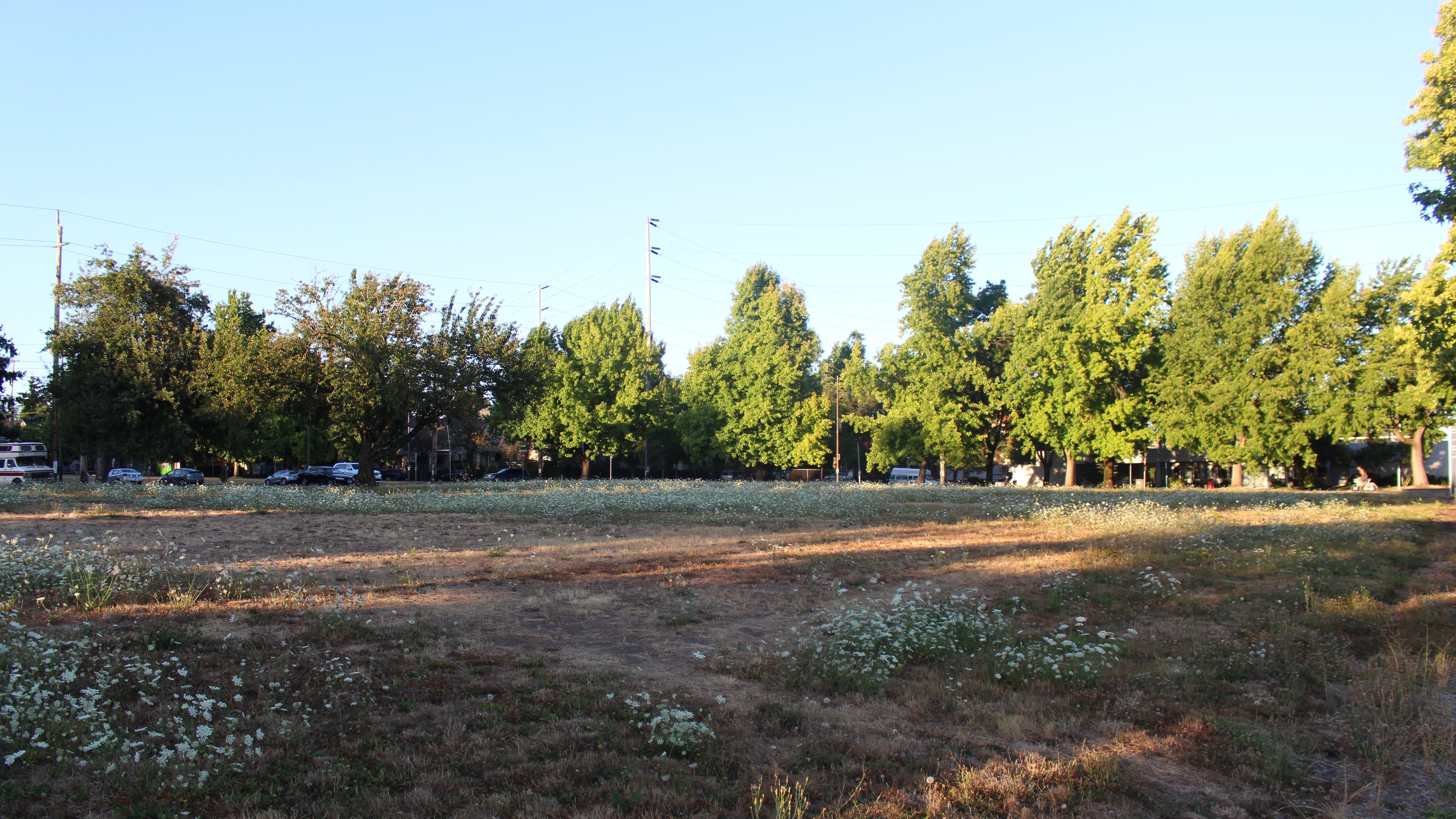Earlier this summer, the Portland Clean Energy Community Benefits Fund awarded a small, 15-month-old organization in Northeast Portland $4.7 million to help build an earth-friendly office building on a vacant 1.7-acre lot across from Emanuel Hospital.
PCEF’s written description of the project, called the Williams & Russell Communal Office, makes it sound like the money is going directly toward installing solar panels, heat pumps, high-efficiency lighting, and above-code insulation.
It sounds like money for construction. Project activities include installing variable-refrigerant-flow heat pumps, above-code insulation and windows, and high-efficiency lighting and water fixtures. The project would also use mass timber for the primary structure, rather than steel or concrete, reducing the building’s “embodied energy,” PCEF said in its description of the grant.
But language in the 55-page application from Williams & Russell CDC, a nonprofit founded in April 2021, tells a slightly different story. There, the PCEF funds sound more like seed money to get the $24.3 million project going, not end-stage construction funds to get it finished.
The question is whether this is mission creep. Voters directed PCEF to use tax dollars to curb emissions and maximize the economic benefits of green energy in low-income communities of color, where climate change takes its biggest toll. With Williams & Russell, PCEF may be using the money instead to back a speculative commercial real estate development in a city that’s already rife with vacant offices.
“The hope is that the PCEF implementation grant will stand as the foundation and catalyst for our funding efforts and signal to other organizations that the Communal Office is worth their investment,” Williams & Russell says in its application.
And, like a venture firm, PCEF is taking on a lot of risk. “While the project mission is compelling and has the right team in place to bring it into fruition, the team may be unable to secure the financing required to fully fund the project.”
Similarly, in an interview with WW, the developer of the project, Anyeley Hallová, said details about how the PCEF money would be spent have yet to be determined.
“The way we thought about it is, a lot of the money up front is more on the planning side and then some of the money is toward the development side,” Hallová said. “I don’t want to get into specifics partly because we haven’t talked to them yet about how that gets administered.”
PCEF awards its grants by category. There are grants for clean energy, workforce development, regenerative agriculture, innovation, and planning.
Williams & Russell got its grant under clean energy, not planning, despite what Hallová suggests.
At $4.7 million, Williams & Russell is the fifth-largest recipient in PCEF’s second round of grants—which totaled $122 million—and the largest for new construction.
Portland’s Bureau of Planning and Sustainability oversees PCEF. The bureau says Williams & Russell fits its specifications for clean energy projects.
“This is not a planning grant,” BPS said in written answers to questions. “Eighty-four percent of the PCEF grant budget goes to construction. This includes both hard and soft costs, as all construction budgets do, including design, architectural/engineering, permitting, project management, materials, equipment, and labor for incremental costs above code.”
The desire to leverage PCEF’s cash to develop a prime piece of real estate that has sat vacant for more than 40 years is understandable. What’s more, the office project would finally reclaim a property where Black-owned homes and businesses were razed in the name of “urban renewal.”
Mayor Ted Wheeler says PCEF is not mandated to play it safe. To the contrary.
“The fund was not designed to eliminate risk,” Wheeler said at the July 20 meeting in which the Portland City Council approved the $122 million in PCEF grants. “With a fund of this type, there is inherent risk. There will be mistakes. There will be dollars that will go to organizations or programs that will not pan out. My presumption is that the voters understood that when they supported this fund.”

Portlanders voted to create PCEF in November 2018. The fund generates money from a tax on large corporations and is now sitting on close to $300 million.
In one way, PCEF has been the victim of its own success, at least in terms of funding. Originally, PCEF was expected to take in around $50 million annually from a surcharge on retailers with annual sales of $1 billion or more in the U.S. and $500,000 or more within Portland.
But a strange thing happened on the way to the tax office. The pandemic hit, and instead of buying airline tickets to Hawaii, Portlanders hit IKEA and Home Depot, driving sales at the big-box retailers that PCEF taxes. PCEF’s revenue hit $63 million in the year ended June 30, 2020, and soared to $116 million the next fiscal year. As of July 1, PCEF was sitting on $298 million, making it one of the largest pools of discretionary money in the state.
Many Portlanders have grown skeptical of PCEF. In March, City Auditor Mary Hull Caballero released a report saying that the fund’s accountability systems were incomplete and that it hadn’t adopted measures to track its performance. The audit came just weeks after The Oregonian reported that one of the largest recipients of PCEF funds to date was founded by a woman who had served time in prison for defrauding energy companies.
City Commissioner Mingus Mapps voted to approve the PCEF grants at the July 20 meeting, but he had reservations.
“I’m a little bit uncomfortable spending $100 million when we have a fresh auditor’s report,” Mapps said at the meeting. “Before we come back here in a year, I hope we have a chance to engage with some of the questions, concerns and reforms proposed by the auditor. Having a sense of what we’re trying to achieve and buy with these dollars would be very helpful to me.”
Williams & Russell plans to build on ground the Black community holds dear. Known as the Hill Block for a building that once stood there, the lot sits at the center of the Albina District, where, between 1960 and 1980, the city and the Oregon Department of Transportation acquired 1,000 houses through eminent domain and, in the name of urban renewal, bulldozed them all.
In 1980, the Portland Development Commission, now known as Prosper Portland, deeded a portion of that land to Emanuel Hospital so it could expand. That parcel has been empty ever since, an open wound for Black Portlanders who were evicted.
Legacy Health, now owner of the hospital, plans to deed the land, which the county assessor values at $2.3 million, to Williams & Russell. Lawyers are working on the transfer, Legacy spokeswoman Vicki Guinn says, but no date has been set.
Beyond its short history, Williams & Russell has other attributes of a venture-backed startup. Bryson Davis, the president, and Hallová, the developer, are highly educated. Davis has a bachelor’s degree from Reed College and a law degree from the University of Washington. He has spent most of his career in corporate law, most recently at Sussman Shank LLP. He left there in December to join PNW Business Law in Vancouver, Wash.
Hallová, meantime, earned a bachelor’s degree from Cornell University and two master’s degrees, one in landscape architecture from Harvard University and another in city planning from the Massachusetts Institute of Technology.
She has worked on marquee projects in Portland, including the Meyer Memorial Trust headquarters and Framework, which was going to be the first wood-frame high-rise in the U.S.
Framework won a slew of awards, including the U.S. Tall Wood Building Prize from the U.S. Department of Agriculture, which came with $1.5 million for research into tall wooden buildings. (Framework construction is on hold, according to its website.)
So far, Williams & Russell has just a conceptual design for the four-story office tower, a five-story apartment building, and 23 townhomes, all at affordable rents and prices.
“Our vision for the site is to create a place of opportunity for the Black community,” Williams & Russell said in its proposal. “This opportunity can come in various forms—through business enterprise, career development, art and expression, or by being able to call this place home.”
Williams & Russell says the design phase will last beyond the middle of 2023. It hopes to get a building permit in April 2024 and complete construction by June 2025.
All of that, according to Williams & Russell, is contingent on getting more funding, something it hopes the vote of confidence from PCEF will help it do.
“We’re going to need a lot more funding for the full buildout,” Hallová says.

